#Meiji Tofu
Text
Meiji Tofu, 16440 S Western Ave, Gardena, CA 90247

When it comes to tofu makers in Southern California, Meiji Tofu stands above the rest. It’s used at the better restaurants, carried by Japanese grocers and specialty grocers, and is the only brand of tofu made by a Japanese tofu maker in the LA area. The tofu is handmade daily in small batches with non-GMO organic soy beans.
They sell what they make out of a small office. Choose from regular tofu, supreme tofu (made with double the amount of soy beans), soymilk, fried tofu, and okara.
Soymilk ($3): Crazy thick, unsweetened soy milk. It’s the thickest I’ve ever had. Takes some getting used to but it’s good.
Deep fried tofu/ atsuage ($5) for a block of two: Probably best freshly fried, wasn’t wowed by it though the tofu was creamy and naturally sweet.
Cash only.
4.5 out of 5 stars
By Lolia S.
3 notes
·
View notes
Text
Sukiyaki noodle is a Japanese dish that has been enjoyed for centuries. This dish is a type of hot pot, which is a communal meal where a variety of ingredients are cooked together in a flavorful broth. The sukiyaki noodle dish consists of thin slices of beef, vegetables, tofu, and glass noodles that are cooked in a sweet and savory broth made from soy sauce, sugar, and mirin. The dish is typically served with a raw egg that is used as a dipping sauce for the beef and noodles.
The origin of sukiyaki noodle dates back to the Edo period in Japan, which lasted from 1603 to 1868. During this time, the dish was known as "gyu-nabe" and was considered a luxurious meal that was only eaten by the wealthy. However, after the Meiji Restoration in 1868, Japan began to modernize and sukiyaki noodle became more widely available to the general public. Today, the dish is a popular comfort food in Japan and is enjoyed by people of all ages.
One of the reasons why sukiyaki noodle has become so popular is because it is a simple and healthy meal that is easy to prepare. The ingredients used in the dish are often readily available in supermarkets and can be easily prepared at home. Additionally, sukiyaki noodle is a low-calorie dish that is rich in protein, fiber, and other essential nutrients.
Another reason why sukiyaki noodle is so popular is because of its unique flavor profile. The sweet and savory broth, made from soy sauce, sugar, and mirin, creates a rich umami flavor that is both comforting and satisfying. The tender slices of beef and the soft, silky glass noodles also add to the overall texture of the dish, making it a truly delicious meal.
In Japan, sukiyaki noodle is often enjoyed during the winter months, when the cold weather makes it the perfect comfort food. The dish is typically served in a large pot that is placed in the center of the table, allowing everyone to share the meal together. This communal aspect of sukiyaki noodle is one of the reasons why it has become such an important part of Japanese culture.
In conclusion, sukiyaki noodle is a delicious and healthy Japanese dish that has been enjoyed for centuries. Its unique flavor profile and communal nature have made it a popular comfort food in Japan and around the world. Whether you are looking for a warm and comforting meal on a cold winter day or a healthy and satisfying meal that is easy to prepare, sukiyaki noodle is the perfect choice.
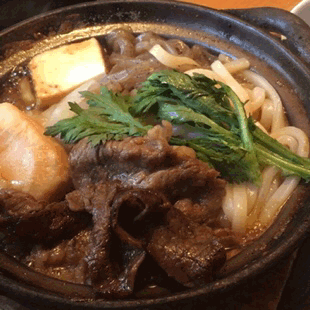
0 notes
Text
Japanese Food

Sushi
Sushi is one of the first foods that spring to mind when we think about Japanese cuisine. This delicacy was one of the first Japanese dishes to be exported to the US after the Meiji Restoration in 1868, and since then its popularity has steadily increased year after year.
The word ‘sushi’ refers to any dish made with Japanese rice that has been seasoned with rice vinegar. Common varieties of sushi include makizushi (sushi rice and fillings rolled up in nori seaweed), nigiri sushi (shaped, bite-size mounds of sushi rice with single slices of raw fish or similar draped over the top) and inarizushi (sushi rice stuffed inside pockets of inari; a type of seasoned, fried tofu).

2. Udon
One of the three main noodle varieties eaten in Japan; udon noodles are thick, chewy, and traditionally made from wheat flour and brine water.
Udon can be served in a number of different ways (mixed into stir fries, added to hot pots, served cold with a tsuyu or tentsuyu soup base on the side for dipping), but are most commonly used in noodle soups, where they are served in a savoury soup broth with different garnishes.
Some of the most common udon noodle soup dishes include kitsune udon (‘fox udon’, topped with aburaage fried tofu), tempura udon (topped with tempura battered seafood and vegetables), and chikara udon (‘power udon’, topped with grilled mochi rice cakes).

3. Tofu
Although tofu is mainly thought of in Western countries as a health food or vegetarian alternative, in Southeast Asian countries like Japan, tofu (particularly silken tofu) is enjoyed by everybody and is a common part of the traditional diet.
To answer the question ‘what is tofu?’, it is soy milk that has been coagulated, with the resulting curds being pressed into blocks. These blocks come in differing levels of firmness, and can be eaten uncooked (perhaps with a couple of savoury garnishes), boiled in hot pots, or fried into tasty pieces of aburaage and used as a garnish.
1 note
·
View note
Text
Meals In Indonesia
Yoshoku is the name of a type of European-style cooking that emerged in the Meiji Era. While lots of Japan’s classic yoshoku dishes have evolved away from their authentic influences, sure parts such as demi-glace sauces are still current on yoshoku restaurant menus. Because yoshoku is tailored to local tastes, Japanese rice plays an important position. Today, round 75% of individuals in Japan eat short-grain varieties of white rice, whereas almost 20% eat this rice combined with other forms of complete grains such as barley or millet. Brown rice, once the most common rice alternative, continues to be widely available in Japan however not as commonly eaten. The third type of rice generally eaten at present is recognized as mochigome, also called glutinous or sticky rice.
Japanese wheat flour noodles enriched with oil to make them skinny and delicate. These elegant noodles are utilized in comparable ways to soba however have a more refined, much less nutty flavor. Though some varieties look comparable, Asian noodles and Italian pasta have some essential variations.
Also known as tofu pudding, it’s a dish Ren and I grew up eating in our native Philippines. Pictured below is a variation of baobing known as xue hua bing. It’s mainly the identical thing but as a substitute of crushed bits of ice, it’s made with sheets of frozen condensed milk. I contemplate myself to be a massive Taiwanese food fanatic, and I will eat everything, however there are gadgets right here that even I even have never tried. Taiwanese food is the best cuisine in the world. Thank you for the invaluable info right here that shows how actually superb, scrumptious and varied the meals is on this lovely little island.
I like to cook dinner Haleem, Biryani, and Spaghetti on weekends. These three are my favourite dishes and I take pleasure in cooking them as nicely. Pasta was ranked as the worldwide favorite meals in a poll conducted by Oxfam into international food trends.
Janitorial Tools
Currently, the HACCP, ISO and PAS 220 are essentially the most generally used internationally approved food security systems. This examine conducts an evaluation of the elements liable for jeopardizing meals security and food security policies all through the world. If your restroom is equipped with paper towels, we encourage you to arrange a compost bin nearby. Equip the bin with a sign that reads "Compost Only" and tell clients why you make the eco-friendly swap. Environmentally acutely aware customers prefer to help businesses who share the same values as themselves and trust us, they will notice and respect your efforts.
Residents of Lincoln & Hunt Housing are to go to their respective housing department to turn in Electronic and Hazardous Waste Material. Hazardous waste turn-in occasions happen off-base in cities surrounding Camp Pendleton all through the month. You can find dates and times for these events by googling hazardous waste recycling. Contact your Base Housing Management workplace for turn-in procedures and packages that apply to your neighborhood.
One resource states that greater than a billion folks went hungry in 2009. The predicament of having meals which are about to go bad could possibly be a possibility for giving back to the society. Additionally, organize the best way you retailer foods in your fridge, pantry, kitchen and so on. For this cause, place new orders behind older ones so that you just use up the older merchandise first. Our focus is your comfort – order online out of your laptop, desktop, or smartphone 24 hours a day, 7 days every week.
There are more than four,400 retail meals amenities in Contra Costa County. Environmental Health conducts regular unannounced inspections of these amenities, and also investigates complaints and reviews of foodborne illness. Inspections and investigations are done to make sure these amenities are sanitary and handling food items in a secure method in compliance with State regulation. If you have an interest in reading extra advantages to adopting food waste administration practices, obtain the complete guide here. Instead of spending cash on wasteful paper plates, harmful Styrofoam cups, and flimsy plastic utensils, put cash into actual dishes and silverware on your workplace café.
Cambro Camtainers Insulated Beverage Containers
Also, since it's transportable, transporting it from place to place in realiableplastic containers, relying on the venue of your occasion will be so much simpler too. The basis of successful catering businesses is making sure that you have got the most effective catering tools. Beautiful enough to capture the eyes of your shoppers and attractive sufficient to have a long-lasting impact not just on their palates but on their reminiscences as well. Order your catering display items and catering disposables today, and have them arrive within a few days. Ordering on-line is easy and fast, with more gadgets shipped out in a single to 2 enterprise days.
Products backed by the most effective warranty in the industry and with financial savings of up to 75% off the worth of similar new gadgets. The insulated meals carrier comes with four caster wheels, 2 with brake, facilitating clean motion and easy transport on the floor. It also combines 2 built-in handles on the top and a couple of elastic handles on both sides, simple for 1 or 2 people to carry and carry.
We are manufacturers of Stainless metal sizzling drink dispenser. Used primarily by motels, eating places, cafes and occasional outlets. For exhibition station cooking, such as omelets, sautéing or saucing pasta dishes, butane burners work properly and are straightforward to move and set up. Off-premise catering is difficult underneath the most effective circumstances.
What Are The Roles Of Catering?
Additional coaching needed to achieve competency within the skills needed on this occupation. The Occupational Employment and Wage Statistics program produces employment and wage estimates yearly for over 800 occupations. These estimates are available for the nation as a whole, for particular person states, and for metropolitan and nonmetropolitan areas. The link under go to OEWS information maps for employment and wages by state and area.
Gathered collectively all food supplies, utensils, decorations, heating components, and serving trays needed for every catering event. How to describe your expertise on a catering resume to get any job you want. Find Caterer job description examples you'll be able to re-use to hire quicker, or use our template to create your own.Read More...
Food service managers are responsible for all capabilities of the business related to staff, including overseeing staffing and scheduling employees for every shift. During busy periods, managers may expedite service by helping to serve clients, course of funds, or clear tables. Home cooks or caterers put together meals at residence and serve it at events and different features.
Handled arrange and repair of meals during events to make sure top quality customer service. Provide excellent customer service by servings patron food and beverages. Learn about the key requirements, duties, responsibilities, and expertise that must be in an occasion coordinator job description. Catering Assistants with master’s degrees are amongst those who work in the trade.
35 Price Range
Fairy lights have become very popular with events as a end result of they're a reasonable approach to add some “magic” to the decor. This example spreads food out over a glass table with fairy lights underneath. It serves as a cheap uplighting and may help seize the theme relying on what kind of lights you employ and the colours. The shimmering Christmas ornaments hanging in the background are additionally a nice touch. By “cool” catering ideas, we mean Insta-worthy alternatives to get your visitors excited and catering appreciation throughout the social networks. Some attendees are solely in it for the bread choice however it can be challenging to spruce it up.
If you would somewhat keep the classic pie shape as an alternative, you presumably can serve mini versions to your guests. These adorable pies are simply as tasty as they are cute. Customize the glaze based on the season for a fresh and distinctive twist. Try a brilliant lemon garlic glaze in the summer or something savory like a pink wine mushroom sauce for the colder months. Central College presents a variety of entrées from easy roast beef, turkey breast or glazed ham to pricier items similar to prime rib. 外燴 use a water dispenser for either water with sliced fruit or cucumber, or ice group.
With tons of of thousands of merchandise available and millions of orders shipped, we have every little thing your small business needs to operate at its finest. Salmon is a basic standby in every chef’s repertoire, but as a substitute of a traditional presentation, mix it up! Pair creamy pasta with pan-seared salmon and spaghetti Carbonara flavors to depart a long-lasting impression.
Food Service Supplies
Even if the adjustments you make are solely short-term, taking further packaging precautions can help ease diners’ worries by showing them you are taking their safety seriously. Coffee Shop Keep traces transferring and drive repeat enterprise with an intuitive POS made for coffee shops. Family Style Turn extra tables and delight friends with a POS constructed for household style restaurants. Food Truck Turn long lines into massive income with a fast and reliable POS for meals vans. •PP containers should be reused 3–208 occasions to have lower impacts than EPS. Aluminum has sharp edges when in comparison with the other takeout container choices and will potentially harm customers.
In general, to be oven-ready, a meals container should have a temperature tolerance of no much less than four hundred levels Fahrenheit. By utilizing ovenable containers, your friends won't have to fret about transferring their meal to other containers, potentially risking unnecessary messes or hurting meals presentation. Our napkins, straws, and cutlery are available quite a lot of weights, colours, and kinds, and are suitable for any occasion. We supply luncheon or dinner quality napkins and napkin bands, wet naps for barbeques, doilies, and placemats, along with tray and table covers. If you've any questions, please be at liberty to contact us, and a meals packaging professional will promptly answer your query. Convenient in function and chic in look, Restaurantware has all of the take out supplies you have to serve your delectable meals to a fast-paced hungry world.
Many plastics are marked with the SPI recycling codes for identification. The technical storage or access is required to create person profiles to send advertising, or to track the user on a net site or across a quantity of websites for comparable advertising purposes. It’s materials savvy, cost-effective, and infrequently, environmentally pleasant. Fast Casual Deliver high quality and convenience at pace with the POS built for fast casual wants.
35 Simple Chilly Lunch Ideas
What’s extra, each meals are loaded with fiber that may assist keep you full between meals . Pick a few one-pot fashion dishes and a carbohydrate like rice or potatoes that can go with each. You can pick a theme, likeIndian, British classics or Chinese, so that individuals can mix and match. If you're making spicy food, make sure a minimal of one is mild as not everybody likes chilli.
Medium-size shrimp are the right size for a twirl of spaghetti shot via with ribbons of squash. Omit the shrimp, double the tomatoes and serve with a spoonful of part-skim ricotta cheese on prime. If you're going vegetarian, protein-packed quinoa is the right meat-substitute on this gentle tomato soup. We love how you can plop a bunch of recent veg into a dutch oven and end up with this intensely delicious, fragrant curry for colder days. You can make a single batch to take pleasure in all week, and serve it with rice, noodles and different vegetarian staples as you go.
I always wish to make 2 desserts as a end result of I wish to have no less than one chocolate / rich dessert and one non chocolate / “lighter” option eg with fruit. These are the dessert combos I’ve done prior to now for various gatherings. You can all the time count in your sluggish cooker to save heaps of on time, effort and mess i... By the time the top of winter rolls round, we're all craving the warm weat...
1 note
·
View note
Note
Did you know Herobrine and Steve loves summer and trendy outfits, because they wish they could meet their brother again to celebrate summer party, for example: Beaches, Disco, Dancefloor, ect. ^_^
Ouh. Well, as for Usagi-Ijah, she likes to spend her time with her friends at Japan, when the summer started, they are planning to go somewhere for holiday, vacation I must say. And their favourite snack or food they would like to eat is kakigori, Japanese shaved ice dessert! With syrup flavour and a sweetener, often condensed milk. She also went to the summer party like, beaches, dancefloor, karaoke to sing, etc! Ouh! And you see Usagi's favourite food is sushi, taiyaki, zaru soba, unagi and yakitori! While Yumaki's (Usagi's 1st friend) favourite food is somen, taiyaki, unagi, sushi, anmitsu and yakisoba. For Mayuki's (Usagi's 2nd friend) is ramen, shabu-shabu, yokan, hiyayakko, and hiyashi chuka. And their most favourite food is mochi, sushi and sashimi! ^^
Taiyaki: A Japanese fish-shaped cake, commonly sold as street food. It imitates the shape of tai, which it is named after. The most common filling is red bean paste that is made from sweetened azuki beans. Other common fillings may be custard, chocolate, cheese, or sweet potato.
Zaru soba: A Japanese dish of chilled soba noodles. The dish is typically served with freshly grated wasabi, thinly sliced scallions, tsuyu (mentsuyu), and a dipping sauce made from soy sauce, dashi (made with both kelp and katsuobushi, or dried bonito flakes), mirin(For Muslim, they usually use vinegar, cuz Mirin is made by alcoholic), and sake(Even sake is also alcoholic, so, Muslim use the vinegar only).
Unagi: The Japanese word for freshwater eel, is an elongated fatty fish, rich and bold in flavor.
Yakitori: Bite-size marinated pieces of beef, seafood, or chicken on skewers
Somen(Aka white noodle): Thin, white, noodles usually served cold and accompanied by dipping sauce.
Anmitsu: A Japanese dessert that dates to the Meiji era. It is made of small cubes of agar jelly, a white translucent jelly made from red algae. The agar is dissolved with water to make the jelly.
Yakisoba(Aka fried noodles): A Japanese noodle stir-fry dish. Usually soba means buckwheat, but soba in yakisoba means Chinese noodles (Chuuka soba) made from wheat flour, and are typically flavored with a condiment similar to Worcestershire sauce.
Ramen(Aka noodle): Quick-cooking egg noodles usually served in a broth with bits of meat and vegetables.
Shabu-shabu: A Japanese dish consisting of thinly sliced beef and vegetables cooked briefly in simmering broth at the table.
Yokan: A jellied dessert or confection made typically from a thick red-bean paste, sugar, and agar, formed into a solid block and eaten in slices.
Hiyayakko(Aka chilled tofu): A classic Japanese side dish. Say bye to "plain old tofu" with colorful toppings like scallions, ham and shiso, and enjoy with a versatile konbu soy sauce
Hiyashi chuka(Aka chilled Chinese): A Chinese noodle style Japanese dish consisting of chilled ramen noodles with various toppings served in the summer.
Mochi: A Japanese rice cake made of mochigome, a short-grain japonica glutinous rice, and sometimes other ingredients such as water, sugar, and cornstarch. The rice is pounded into paste and molded into the desired shape. In Japan it is traditionally made in a ceremony called mochitsuki.
After they done having a fun, they went back to the summer house to rest. And they make barbecue at night for dinner. They also made sandwich too! Peanut butter and jelly sandwich. But, Mayuki had a peanut allergic, so, she eats jelly sandwich only instead peanut butter.
For Neko-Sufi, even she lives her own in the big house at forest, she has friends, Maria, Elisa and Rolanda, she meets at café she usually go. So, she can go to the vacation with them on summer. Like went to the beaches, dancefloor and karaoke to sing. And their favourite snack is s'mores, ice cream, slushy and etc.
S'mores: A sweet snack consisting of a chocolate bar and toasted marshmallows sandwiched between graham crackers.
After they done, they went back to the hotel to rest
2 notes
·
View notes
Photo

In Japanese folklore, the tōfu-kozō is a yōkai that appears in the form of a small child carrying a dish of tofu. They usually wear a kasa and a robe decorated with significant patterns and symbols. They often act as servants for humans, fetching tofu and sake to their masters. Sometimes, they will serve an entire town.
The tōfu-kozō was a significant figure in Japan in the Edo period, appearing in several books and artworks, and in the Meiji period, on toys like cards, board games and kites.
Image source.
Monster master list.
Suggest a spook.
92 notes
·
View notes
Text
i was tagged by @blobbyx2blobfish to make this picrew of myself, thank you sm mel this was really fun!!

i’m always a slut for anything even remotely resembling character creation and if i spent over an hour dicking around and adjusting things on a scale of millimeters then you know what that is my business it doesn’t look exactly like me but i think i got The Vibes down good enough lol
tagging @rrksmith @goldenandyou @spadebrigade @adhd-suga @oiks-tofu @meijis and anyone else who wants to do this!
#as always no pressure if i tagged you#thank u again mel i wasted so much time but its okay thats just what i do lol#also gonna just blame the picrew itself for being so stupidly detailed haha but i loved it#there were so many diverse options thats some good shit right there#.txt#tag game
7 notes
·
View notes
Text
Rules & About

Mun:
Is 25+ Mature themes are to be expected. Just discuss with me what you’re thinking and comfortable with (I don’t default nsfw).
Fun asks and random prompts would be fun. I will respond to almost anyone; it’s interesting to see how muse’s react/respond. I look forward to working with you.
Multiship / Multiverse / OC Friendly / Selective / Private
Activity: I am an adult with a life outside of the internet. Though usually I am good on replies and communication, I understand that sometimes things will get slow. I am not one to abandon my responsibilities and expect you to not either; I assure you I will get back to you. That said:
Prefers to keep certain ongoing RPs private [not on tumblr] out of respect for my partners and to avoid drama. I have absolutely no tolerance for drama.
Literacy & Writing Concerns: I don’t demand perfection but please no lingo or abbreviations in our threads. Also no 1-2 liner responses; I enjoy writing and tend to be multi-paragraph. Would like to work with someone who feels the same.
Shipping: Tends to make things fun. I love all sorts of ships and bonds. Romance, rivals, friends, co-captains -Bring it on!! Can’t say I am down for a forced ship however...If it wouldn’t work, it wouldn’t work; I have to be true to my muse and personal comfort levels. [ There must be chemistry ]
Hakuouki / Shinsengumi / History: friends are always good to have.
I am a long time fan of the Hakuouki game series. All this comes from a lot of cannon experience, which I’m fickle about. As well as RL history and me being a sword enthusiast myself.
Please don’t be shy. I’m a very open minded person.
Discord is available for interested parties (and it is my preferred method). I tend to be there now a days so feel free to hope in and join us to easily reach me
Am absolutely open to broad, non-exclusive RPs. (Such as any Hakuouki RP servers, etc. -Invite me!!) Or if you just want to chat
Muse:
Saitou Hajime from Idea Factory’s Hakuouki. Third Captain of the Shinsengumi
-An Edo(Bakumatsu)/Meiji period samurai inspector skilled in left-handed iai.
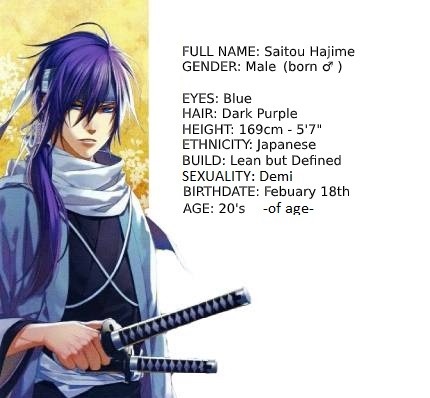
❀ Feel free to inquire with me or below for more info:
Saitou is sharp and rational, sometimes to the point of coldness. However, he is not cruel or violent, just efficient and determined. He takes no pleasure in killing despite his efficiency and skill in a fight (particularly one-strike kill iai). Though he is ordinarily cool and distant, he also has a softer and more sympathetic side, of which he does not always seem fully aware of that makes him understanding in most situations. He sees himself as less valuable then his work and is easier to talk to about work matters or topics outside of himself (you can say he’s more shy and reserved/polite in regards to more personal matters). He is reasonable and will respond to situational logic; very observant and light in his steps. He is not always easy to warm-up to people, however when he does his love & loyalties are strong and fierce.
Saitou is dutiful, responsible and stoic in nature; he rarely questions or complains about a task he is given. Because of this, he tends to get the dirtier jobs assigned to him (more than other subordinates get). But he will use his best judgments and is good at putting up a front (or lying by omission) when necessary to fulfill a task or keep things private. Very determined,/stubborn and self-driven, despite what may be said about his mindful independence (that he only follows orders; his reasonings are far more personal or stubborn then that).
Saitou is a sword enthusiast, is often found training in the early mornings and with his subordinates during the day. He likes to cook, is motivated by the awes of nature and enjoys his hard sake and tofu (and will hardly ever turn down a reason to share a drink so long as he’s not busy with a task). Can be found reading/researching on occasion or laying low around town while undertaking investigation work. Holds strong morals/ethics and is extremely disciplined with them (to the point of being too hard on himself sometimes, but such is how one builds such strong fortitude / inner strengths). Can be very sentimental and is initially reserved in nature when in more personal situations. His honors as a man and warrior/samurai are strong; his resiliencies and tolerances are high to the point that he may seem immovable at times (refusing to ‘stay down’ during a fight). However...every man has his weakness: If you can find it in him.
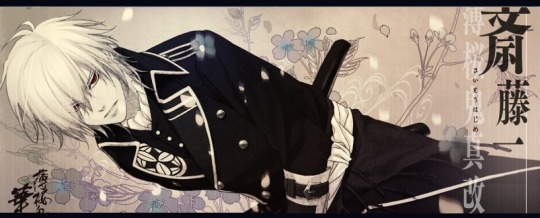
For those familiar with Hakuouki:
Rasetsu/Fury mode: is described as ‘like a fierce god’ on the battlefield; next to impervious and dependent on the scenario fully mentally competent and ruthless; swift and efficient. Will call upon ‘the ultimate evil in himself’ to combat injustice and fight for what he believes in. Would be more opt not to succumb to a bloodlust urge then ask for help.
I default Historical Muse ^ but also:
SSL Universe:
School/college setting: Working under the disciplinary committee in HS, practices kendo and is looking to gain high academic achievements in the fields of criminal justice, law and psychology.
Modern/Alternative/Futuristic AU’s
Most likely found working as a detective/inspector in the police department; has a penchant for swords and weaponry. He is stern, disciplined and stoic but has a hidden gentle side deep in there. Adversaries: Feel free to see how far you can manipulate him. His logical and down-to-earth nature makes him easy to work with if you know how to correctly reason with him. Fights for the ultimate ‘right’ (whether or not it’s ‘to the book’).
All are interesting to work with to character build and expand upon. I am open to try almost anything. Keeps things fun.
#starting fresh#rules#about#mun#Saitou Hajime#Hajime Saito#Hajime Saitou#roleplay#rp#hakuouki roleplay#hakuoki
2 notes
·
View notes
Text
LA Farmhome, 3389 Eagle Rock Blvd, Los Angeles (Glassell Park), CA 90065

LA Farmhome is one of the specialty bodega style grocers similar to Cookbook Market, Altadena Beverage, and Windrose Provisions. I visited during a weekday and my eyes were drawn to their lovely fresh flowers and fresh produce.
Pantry items include spices, sauces, condiments, teas, coffee beans, pasta, olive oil, beans, pasta, jams, canned fish, etc. In the refrigerator, they had kraut, Anson Mills grains, Meiji Tofu, kim chi, cheese, Pizza Baby salads, salsa, yogurt, drinks, milk, farm fresh eggs, etc. They had fresh focaccia and prepared foods from Ceci’s in Silver Lake, ice cream from Mother Moo’s in Sierra Madre, coconut based ice cream from Awan, Meadows frozen pierogi, etc. I don’t think they carry wine or spirits.
They also have a home section with vintage ceramics and tableware, linens, and cookbooks. Parking has become tough to find in this area (the Bub & Grandma’s effect?)
4 out of 5 stars
By Lolia S.
#LA Farmhome#specialty grocer#grocery shopping#groceries#grocer#Glassell Park#Ceci's Gastronomia#Mother Moo's#fresh produce#fresh flowers
1 note
·
View note
Text
Day 11: Future
“What do you think life was like for people in the past?” Maribel asked.
Renko Usami paused, and put her fork down, as she finished chewing her bite of the meal. A few years ago, before she had met Maribel Hearn, this question would have left her grasping at straws, struggling with how vague it was. But she had grown used to Maribel’s thought process, so she thought for a moment, before swallowing.
“How do you mean?” Renko asked in reply. “How long ago? Like the Meiji era, or like the Heisei era? And what do you mean by ‘How they lived?’”
“I was thinking around the Reiwa era, but sure, let's go with the end of the Heisei era, around 2018 CE,” Maribel said, taking a sip of her drink. The two were at an outdoor restaurant, one that advertised itself with powerful ion-filters, so you could actually enjoy the outdoors, without masks. “As to the ‘how’...I mean what they ate regularly, how they communicated, what they did everyday.”
“Well, we still have all the archived social media from back then, so we know how they talked on the web, and what their daily concerns were.” Renko paused, looking out over the town. Kyoto still retained it’s ‘older’ character against the other flooding megatropolises in Japan, it being the only non-coastal major city. “They were worried about all the same things we do; money, family, the state of the environment, what to do for leisure. Apparently discussions of the state of their entertainment was one of the bigger topics, alongside occasional end-of-the-world hysteria.”
“And what do you think they ate?”
“Oh no, Mary, I got that last one, you go this time.” Renko countered. Maribel stared down at her meal; a fried cutlet of tofu and mushrooms, once made as an alternative to pork, now almost the only option, with a side salad of mostly synthetic lettuce, and American-style iced tea.
“Well, I know way fewer plants and animals were extinct back then, so they probably had more real meats and vegetables,” she said, after a minute of chewing.
“You’re right on that one,” Renko said, finishing the last bite of her teriyaki veggie roll. “Although, the end of the Heisei era and into the Reiwa era is when meat replacements really started to take off, in popularity, so it wasn’t all real animal bits.”
“But it wasn't a matter of availability, like now,” Maribel countered “They were both equally easy to get, and they cost the same.”
“Yes and no. Some couldn’t eat animal meat for health reasons, some didn’t for religious or moral reasons,” Renko offered. “It’s never quite as simple as ‘they could have it, so they did’.” There was a long pause, as Maribel chewed.
“What do you think they dreamed about?” she asked as she finished her meal. Renko thought about that for quite a while.
“I once read my grandmother’s journal,” she said, slowly. “Beyond all the worrying about popularity and her schooling and whatnot, she wrote about seeing a land full of strange beasts and heroic warriors in her dreams. I don’t really know what to make of it.” Renko looked up to see Maribel staring off into the distance, looking at something only she could see. Renko recognized “Mary’s Boundary Stare” and tapped the payment ring with her phone, settling both their checks. She stood up, putting her jacket back on. “Well, should we get going? I feel like Dr. Latency has a new tale to write.”
“Yes, I do believe you are right,” Maribel smiled. “Time to see the unseen.”
27 notes
·
View notes
Text
Ikemen Sengoku Kyoto Tourism campaign
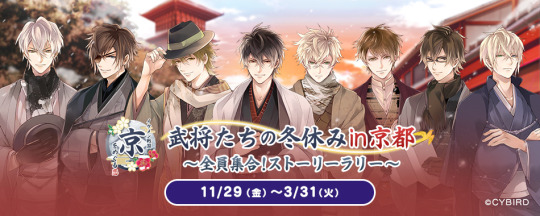
The hotspots can be found on this link: http://www.toei-eigamura.com/event/detail/254
The sites are:
- The Honnouji monument (the place where MC and Sasuke timetravelled)
- The present day Honnouji (built by Hideyoshi, in the modern day the entry is in the middle of a shopping strip, keep a lookout or you might miss it due to the vendor carts and such distracting you)
- Kenkun Jinja/Takeisao Shrine. A shrine built by Emperor Meiji to revere Nobunaga and his son as deities.
- Randen train line. It’s a tour-oriented train that has stops in various tourism highlights.
- Toei Eigamura (studio park). In it are various attractions related to movie making, and recreations of movie sets that you can take photos in (or use as drawing references I guess, if you’re an artist). This place is also part of the above Randen line.

Collab menu provided by Toei Eigamura
http://www.toei-eigamura.com/ikemen/food.php
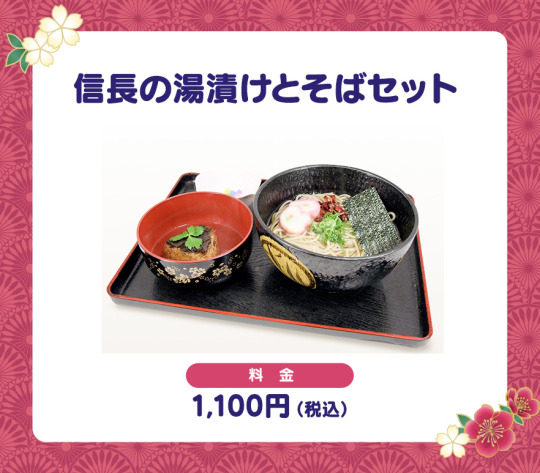
Nobunaga’s Yudzuke and soba set: Yudzuke is a quick meal of rice dunked in hot water. It’s said to be Nobunaga’s preferred food due to his impatient personality. A common story also involves Nobunaga eating a quick meal of yudzuke before Okehazama.
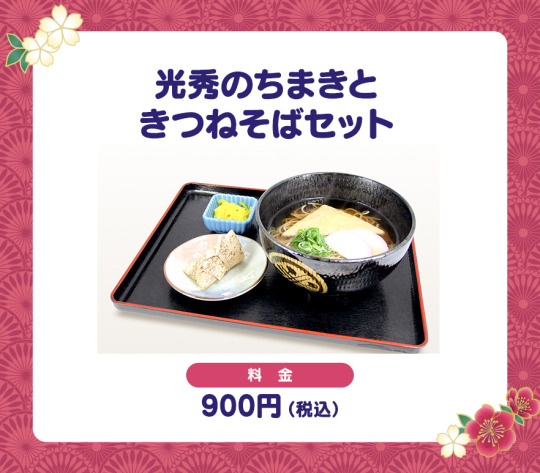
Mitsuhide’s chimaki and kitsune soba set: Chimaki is said to have been the food Mitsuhide liked. Kitsune soba is soba with fried tofu topping, named such because kitsune are believed to like tofu.

Hideyoshi’s ground rice gruel and miso oden: Thin porridge made from pounded rice is said to be something that Hideyoshi either favours, or just eats out of habit due to his humble origins. Red miso is a specialty of Nagoya (Owari in the past).

East army is cool! Colourful Japanese parfait
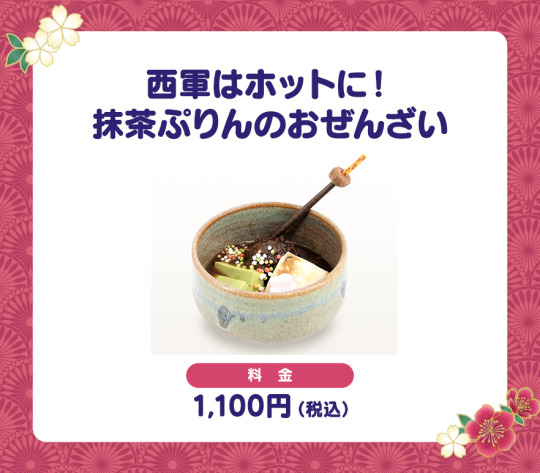
West Army is hot! Maccha pudding zenzai (zenzai, a.k.a oshiruko, is sweet red bean soup, often topped with mochi)
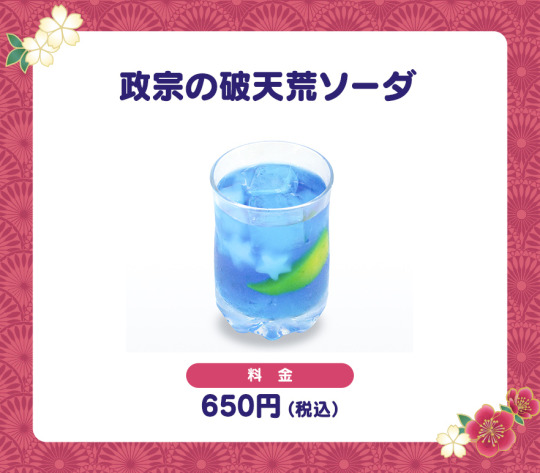
Masamune’s unprecedented soda
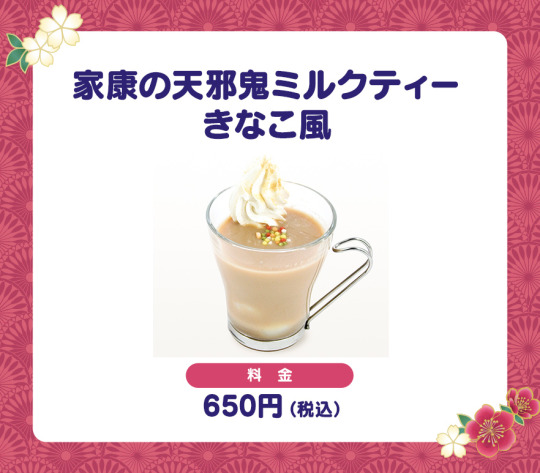
Ieyasu’s contrarian milktea, with kinako
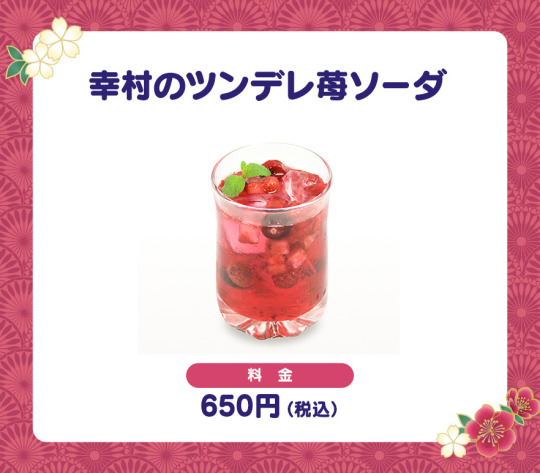
Yukimura’s tsundere strawberry soda
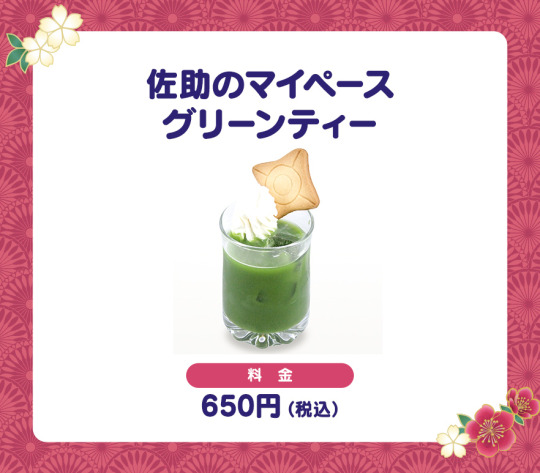
Sasuke’s easygoing green tea
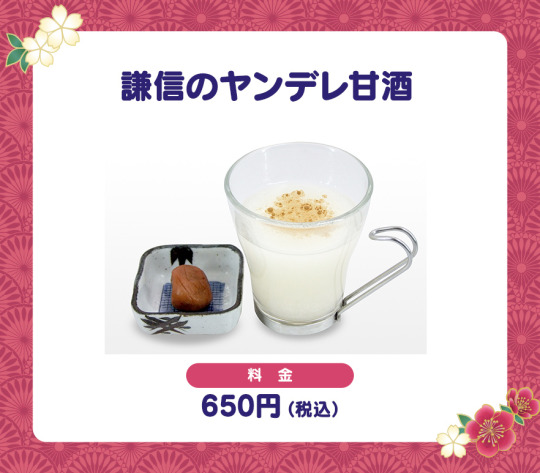
Kenshin’s yandere sweet sake (plus umeboshi)
(WHERE IS KENNYO, WHAT IS THIS INJUSTICE)

You get a special coaster when you purchase the special food.

Special merch
http://www.toei-eigamura.com/ikemen/goods.php
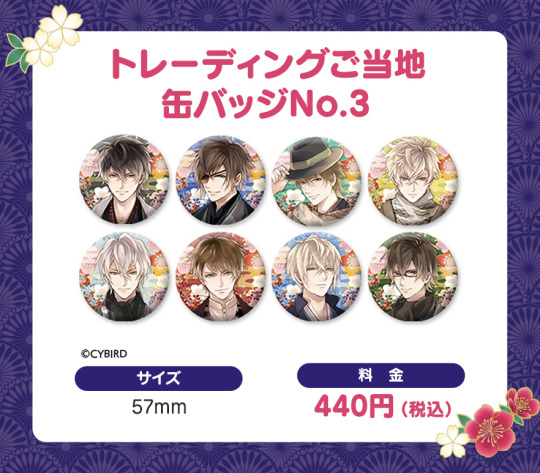


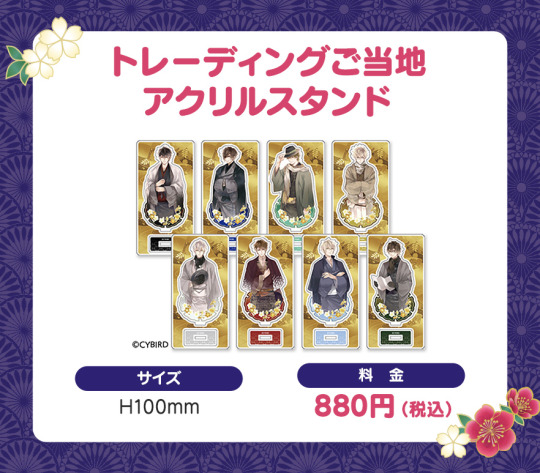
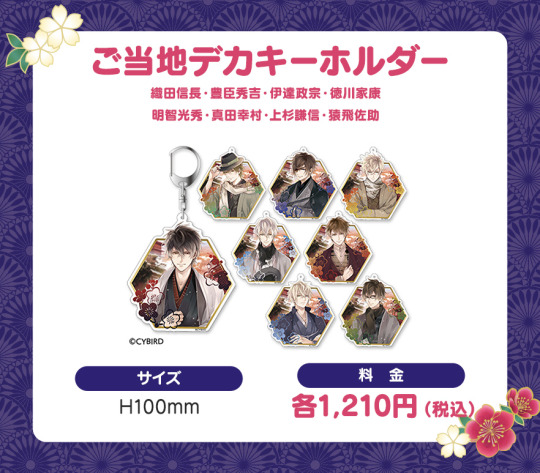

36 notes
·
View notes
Photo
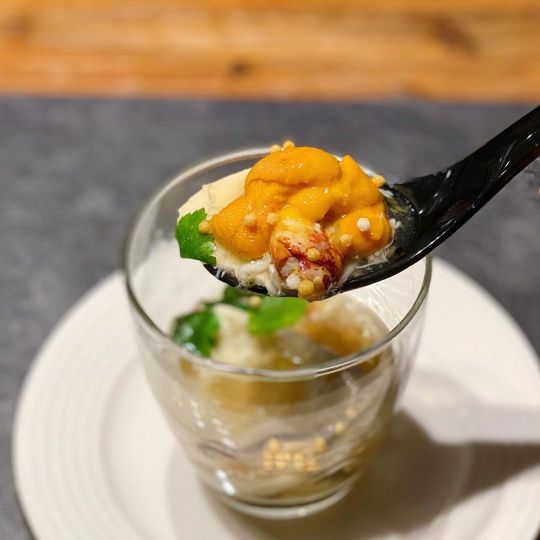
🦀🤤 Dungeness crab ankake, meiji tofu, shiitake, yuzu, rice puff, chili oil, Hokkaido uni • 📍Noodle in a Haystack, San Francisco USA #noodleinahaystack • #japanesefoodie #japanesefood #japanesestyle #japaneseculture #japaneseart #japanesecuisine #oishii #oishi #itadakimasu #bayareaeats #sfeats #sfbayarea #sfbay #dalycity #yummy #crablegs #crab #crabs #dungenesscrab #tofu #shiitake #soy #finedining #finedinning #finedininglovers #finedine #seaurchin #uni #seafood (at Noodle in a Haystack) https://www.instagram.com/p/B9E5k6Uhase/?igshid=got1ik3qbkwo
#noodleinahaystack#japanesefoodie#japanesefood#japanesestyle#japaneseculture#japaneseart#japanesecuisine#oishii#oishi#itadakimasu#bayareaeats#sfeats#sfbayarea#sfbay#dalycity#yummy#crablegs#crab#crabs#dungenesscrab#tofu#shiitake#soy#finedining#finedinning#finedininglovers#finedine#seaurchin#uni#seafood
2 notes
·
View notes
Text
June 6th - Fushimi Inari
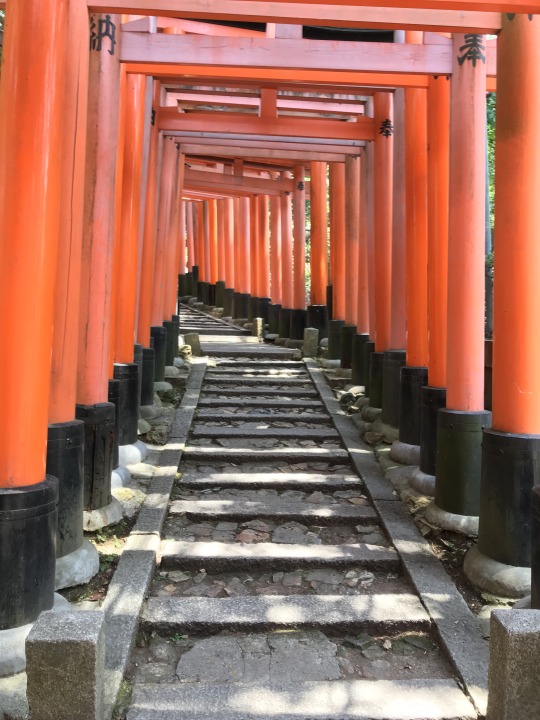
Rows of Torii at Fushimi Inari
Today we went to what I think is the most iconic thing to see in Kyoto - Fushimi Inari, or the mountain of ten thousand gates. We had the option to leave at 7am or 9:30, and although I voted for 7 (otherwise its impossible to get the photos everyone wants), 9:30 got the majority. I started my morning at 7:30 to help clean up from Lord of the Rings night a few doors down, and then we headed over to the shrine.
From the moment we got off at the stop for the shrine I could tell it was going to be a good excursion. The station was decorated with foxes, and Inari sushi was offered at a small stall. Fun fact - Inari sushi is named because fried tofu is apparently a favorite food of foxes. We headed up to the shrine, which was super impressive. There were statues of foxes everywhere, and much of it was painted in the red-orange color meant to ward off evil spirits. We started up the trail to the summit, which began with huge torii one after the other and also a million people crammed in together. As we descended, though, the people grew less and less and I was able to get one picture without other tourists in the shot.
The ascent itself wasn't nearly as bad as Mt. Takao in Tokyo. Everything was paved and had stairs, and the angle of elevation was much less steep, save one or two stretches. We met another group back down the mountain and headed home. Even though climbing wasn't bad, it was still really hot today so I really needed a shower. It's 3:30 now, and I have a few things I want to get done. I need to scope some stores to get my brother the things he wants, and tomorrow is Seth's birthday so we’re all going to do something for him tonight.
Professor Smith mentioned today that we should try to do as much as we can while we’re here, because we can watch a movie in America. I’m trying, but I feel a little bit in a rut. For one, we get out earlier in Kyoto, so we have more time on our hands and it feels a little like we live here. So it’s easy to fall into a pattern of normal life, staying in and reading and ordering pizza.
Academic Reflection
The reading for today was about Inari, and the history surrounding the shrine and god/goddess. One thing I thought was really interesting was reading about how the shrine adapted after the separation of Buddhism and Shintoism by the Meiji government. Inari has been a diety of both religions for ages, so when Buddhism was forced out of the premises, people had to adapt. Buddhist believers set up rock altars higher up on the mountain despite the prohibition on them, and some of these still exist. While climbing, we passed one or two hidden in fields of tori or around curves on the path. It was cool to be able to see these and understand the history behind them.
Another cool thing was just how different Inari is seen at different levels. It is even debated whether or not they are a man or a woman. Priests believe that Inari was not a fox, and used them simply as messengers, but it is a common belief of the average shrine goer that Inari is, in fact, a fox. It was fun walking through the throngs of people and knowing that they all came from different backgrounds and believed different things, but still were brought together in worship and to see the beauty of the shrine.
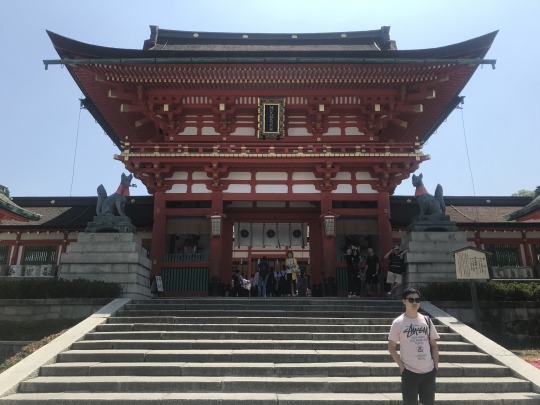
Outside of Fushimi Inari Shrine

View of Kyoto from an outlook near the summit
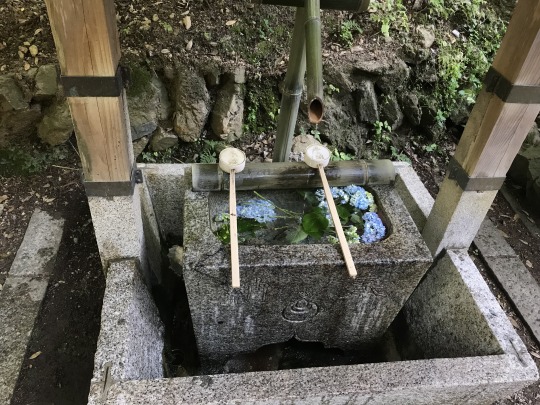
This fountain is used to purify you before you enter a shrine. This was next to a small one on the way up, but it had these pretty flowers in it and I liked it a lot
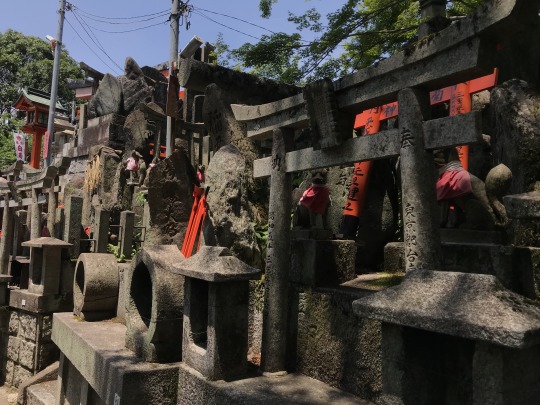
Some paths along the way had these arrays of tiny stone torii with fox statues around them
#japan#japanese#kyoto#fox#buddhism#shintoism#shrine#temple#inari#fushimi inari#torii#culture#travel#study abroad
2 notes
·
View notes
Photo
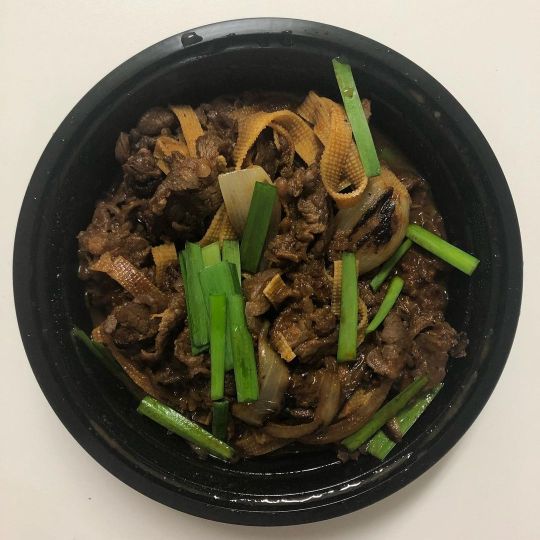
Spicy Bulgogi • Sugar Snap Pea with Apple • Asparagus Muchim • Bokchoy Muchim • Black Bean Broccolini • Gimbap • Ginger Soy Braised Yam • Meiji Tofu with Gochujang Meat Sauce • Marinated Dashima from @_perilla.la pop-up 🇰🇷 . ❌ STOP ASIAN HATE ❌ . . #eeeeeats #eatstagram #foodstagram #forkyeah #foodie #tryitordiet #instafood #goodeats #food #bestfood #tastyfood #foodporn #devourpower #lafoodie #hungry #foodshare #popup #photooftheday #latergram #losangeles #eat #foodpic #imhungryla #nofilter #lunch #delicious #f52grams #korean (at Hancock Park, Los Angeles) https://www.instagram.com/p/CQg4X7jDRsA/?utm_medium=tumblr
#eeeeeats#eatstagram#foodstagram#forkyeah#foodie#tryitordiet#instafood#goodeats#food#bestfood#tastyfood#foodporn#devourpower#lafoodie#hungry#foodshare#popup#photooftheday#latergram#losangeles#eat#foodpic#imhungryla#nofilter#lunch#delicious#f52grams#korean
0 notes
Text
Japan
Research Essay - missing some pictures from the original document.
Japan is an archipelago on the eastern edge of Asia, formed by 4 main islands: Hokkaido, Honshu, Shikoku, and Kyushu, plus nearly 4,000 other smaller islands. It has a population of 126,168,156 people, and its area is comparable to that of California or Germany. As a country, it is completely sea-locked, with its nearest neighboring countries being the Siberian region of Russia to the north, North and South Korea and China to the southwest. Almost four fifths of Japan’s land is covered with mountains and forests – the largest mountain range being the Japanese Alps. Japan has about 200 volcanoes, 60 of which are active, with Mt. Fuji being the most famous one and the highest mountain.
Japan has 47 prefectures contained within 8 regions: Hokkaido, Tohoku, Kanto, Chubu, Kansai, Chugoku, Shikoku, and Kyushu.
Humanity in the Japanese archipelago can be traced back to 30,000 B.C. However, the country’s history in itself would rather be explored some time before the 2nd century, during the Jomon and Yayoi Periods, where communities first begin to establish and see the appearance of metallurgy and agriculture. This is the foundation of Japan. The Kofun Period, before the year 538, was when the Yamato clan had great control of the island of Honshu. From 538 to 710 came the Asuka Period, in which the history was enriched with and influenced by the already established Chinese civilization. This period saw the introduction of Buddhism, writing, architecture and sculpture. After that, with the Nara Period came the affirmation of the central power of the emperors, plus the construction of the first capital in Nara and its great temples. The Heian Period came after Nara, from 794 to 1085. The capital was relocated to what is today known as Kyoto. Japan was heavily influenced by China and adopted its style of power, where the clan Fujiwara ruled. With the Kamakura Period, which ran until 1336, the imperial court’s power faded to give place to the samurai clans and the first government of warriors. The Muromachi Period (1336-1491) introduced Japanese feudalism and the fusion of the culture of the samurai and the court, resulting in arts such as the tea ceremony and Noh theater. However, the central power disappeared in The Sengoku Jidai (1491-1603), due to repeated civil wars. Here appeared the Daimyo Warlords, the first contact with Europeans and the introduction of Christianity. In the Edo Period, from 1603 to 1853, Japan was unified under the 3rd Tokugawa Shogunate (government of warriors) and the power was installed in Tokyo. The borders of Japan were completely closed to foreigners and Christianity was prohibited. The country was urbanized and rich merchants developed, just like the Kabuki theater and Nihon printmaking. At the end of Edo, The Bakumatsu (or Late Shogunate, 1853-1868), Japan was forced to open its borders by the Americans, leading to the overthrow of the Tokugawa. This began modernization and industrialization in Japan. The Meiji Era, from 1868 until 1911, restored imperial power and relocated it to Tokyo (previously known as Edo). That is when electricity and the railway first arrived. Japan conquered Korea and Taiwan and was victorious against the Russian Empire and China. In the Taisho Era (1911-1926), the democratic system was first implemented. The Showa Era (1926-1989) began the imperialistic politics and military government and the expansion policy towards China, which involved Japan’s entry in WW2. After its defeat in 1945, the reconstruction of the country was managed under American trusteeship. The Heisei Era (1989-2019) is marked by economic crisis and natural disasters, but also the influence of Japan over the rest of the world. On May 1st, 2019, Emperor Naruhito acceded to the Chrysanthemum Throne, beginning the Reiwa era.
Logically, the official language of Japan is Japanese. The language is based on writing syllables in Hiragana, the traditional set of symbols, and Katakana, mainly used for words that do not exist in traditional Japanese (for example, the word “television” is written as “terebi.”). Japanese also uses Kanji, which is a set of thousands of Chinese characters that have been imported to the Japanese language. Most of the meanings remain the same, but their pronunciation has been adapted to being read in Japanese syllables. Kanji is used to “simplify” Hiragana (i.e. instead of writing two or three characters in Hiragana, you would write only one character of Kanji,) and for proper names.
The most predominant religions are Shinto and Buddhism, respectively. Buddhism was introduced through mainland Asia in the 6th century, but Shinto is almost as ancient as Japan itself. Even though these are the two major religions in Japan, religion on its own does not play a heavy role in the everyday life of Japanese people. Shinto literally means “the way of the Gods;” Japanese gods are called “Kami.”
The core of Shinto are beliefs in the mysterious creation and harmonizing power (musubi) of the kami, and the truthful way or will (makoto) of kami. The nature of kami cannot be fully explained in words because the kami transcend the cognitive faculty of humans. Parishioners of a shrine believe that kami are the source of human life and existence. Each kami has a divine personality and responds to truthful prayers, and may reveal makoto to people and guide them to live in accordance to it. In Shinto, it is commonly said that “man is kami’s child.” First, this means that people are given life by kami and that their nature is therefore sacred. Second, it means that daily life is made possible by kami, and, accordingly, the personalities and lives of people are worthy of respect. Individuals must revere the basic human rights of everyone (regardless of race, nationality, and other distinctions) as well as their own. The concept of original sin is not found in Shinto. Purification is considered symbolically to remove the dust and impurities that cover one’s inner mind.
In Shinto, all the deities are said to cooperate with one another, and life lived in accordance with a kami’s will is believed to produce a mystical power that gains the protection, cooperation, and approval of all the particular kami.
Notable kami revered at Shinto shrines include: Amaterasu Omikami (the Sun goddess), Inari Okami (god of rice and agriculture), Izanagi (the first man), Izanami (the first woman), Tsukuyomi (the Moon god), Raijin (god of lightning, thunder and storms), and many more.
Shinto is also described as a religion of tsunagari (continuity or communion). The Japanese, while recognizing each human being as an individual personality, do not take each to be a solitary being separated from others. On the contrary, one is regarded as the bearer of a long continuous history that comes down from one’s ancestors and continues in one’s descendants.
In practice, Shinto does not have a weekly religious service like in Christianity. People may visit shrines at their convenience. Some may go to shrines on the 1st and 15th of every month, and on rites or festivals (matsuri) several times a year. Devotees may pay respect to the shrine every morning. The Japanese usually have their wedding ceremonies in Shinto style and pronounce their wedding vows to kami. Shinto funeral ceremonies, however, are not popular. Most of the Japanese are Buddhist and Shintoist at the same time and have their funerals in Buddhist style. A traditional Japanese house has two family altars: one, Shinto, for their tutelary kami and the goddess Amaterasu Omikami, and another, Buddhist, for the family ancestors. Pure Shinto families, however, will have all ceremonies and services in Shinto style.
Each Shinto shrine has several major festivals each year, including the Spring Festival (Haru Matsuri), Autumn Festival (Aki Matsuri), Annual Festival (Rei-Sai), and the Divine Procession (Shinko-Sai).
At festivals, Shintoists may perform different types if rituals at the shrine, such as: Purification, Adoration, Offerings, Prayers, Sacred Music and Dance, Feast (naorai), etc.
As history has shown, Japanese people are very proud and respectful in their everyday life, as such many customs and manners have been developed that many foreigners may think of them as strange or unnecessary. At the start of a meal, it’s common to say in a brief prayer pose “itadakimasu” (I humbly receive). When eating dinner, it is inappropriate to eat directly from common dishes (where everyone can grab a portion of food), as you should put your portion on your plate first, and to reach for the item closest to you and at the top of the plate. If someone else is picking food from a common dish, give them some space. Also, playing with chopsticks, or using them for anything other than eating, is considered disrespectful, because the chopsticks may contain your saliva or traces of food and so they should be flung around in the air as little as possible; use chopstick holders whenever you’re not eating. Do not try to stab food with your chopsticks. If a chopstick is messy, let it be messy, and do not try to pass food chopstick-to-chopstick, as it resembles a funeral. At dinner parties, it’s somewhat rude to pour your own drink. As such, you should pour everyone else’s drink except yours, someone will notice and pour your drink. Walking and eating is seen as sloppy. “Gochisosama Deshita” (It was a feast) is used to thank someone for preparing a meal or for paying the bill (someone else paid) and compliment good service (paid yourself). The traditional Japanese diet consists of minimally processed, seasonal foods served in a variety of small dishes. This style of eating emphasizes dishes’ natural flavors rather than masking them with sauces or seasonings. The diet is rich in steamed rice, noodles, fish, tofu, natto, seaweed, and fresh, cooked, or pickled fruits and vegetables but low in added sugars and fats. It may also contain some eggs, dairy, or meat, although these typically make up a small part of the diet.
Keigo (honorific language) is a polite level of speech that includes different levels of humble, formal and respectful terms. It is complicated to master this level of speech, even for native speakers of Japanese, as some situations may not require it or the incorrect term was used. However, it is considered very rude to avoid using keigo. It is most appropriate to address someone by their last name followed by the polite suffix “-san.”
Oseibo and Ochugen are winter and summer gifts respectively given at year-end and around Obon (Festival of the Dead) given to relatives, neighbors and anyone who has helped you out in the past year, such as a doctor or teacher.
When greeting, the Japanese understand that foreigners tend to shake hands; nonetheless, shaking hand is more usual for business introductions. The usual way to greet is a bow, the deeper the bow, the higher the respect given… or the higher the shame felt by the person bowing, according to the situation. Bowing can go from just slightly nodding your head downwards, to being in a 90 degrees angle directly looking down, and a lazy bow is considered disrespectful. Getting on your knees (seiza) with your head down is used in deep prayers or when begging for forgiveness, as if you are experiencing intense shame. Bowing and shaking hands at the same time is seen as awkward. The formal bow is usually 45 degrees.
Try not to touch another person, as the Japanese are generally uncomfortable with physical interaction. Pointing is also considered rude and threatening. Instead, people tend to indicate directions with an open hand or even avoiding gestures at all. When feeling uncomfortable, the Japanese tend to be indirect and try to avoid conflict where possible, dropping subtle hints about their feelings rather than direct, bold statements. Japanese people are very patient and resist honking at other drivers out of irritation. Brief honks and light flashing is most often used in friendly gestures, such as warnings. When accepting a call, try to be discrete and very quiet, and not to talk on the phone on a train or in a café. In an elevator, the person closest to the buttons operates the doors and should help people select their floor. The person nearest to the door should also be the last one to get off. It is customary to take off any backpack on a crowded train and hold it in your hands. Many taxi doors in Japan are automatic, and the driver will get a little upset if you operate the door yourself. Tipping servers at restaurants or taxi drivers can be considered insulting or at least confusion. Walking and smoking is viewed as dangerous and inconsiderate, being the idea that you could accidentally burn someone on a crowded street. In Japan this is taken very seriously, and it might even be illegal to walk and smoke in some areas.
When entering a home and many establishments where you can rest, the entrance will have a space to change your shoes for indoor slippers. This is done as to not to bring the impurity and uncleanliness of the world into your home. Tatami floors (made from rice straw or compressed wood chips) are common on traditional households, and no kind of slippers or shoes should walk upon them. Bathroom slippers are exclusive for use in washrooms and bringing them into other rooms in considered shameful. In Japan, bathing is seen as a relaxing leisure activity rather than an act of cleansing. One must completely shower with soap before entering a bath; this applies for home baths and public hot springs (onsen). There may also be available garden slippers for balcony, garden or outside use. Japanese cultural activities, such as theatre and tea ceremony tend to require formal wear. Restaurants and office work usually do too.
Because the Japanese have a deep philosophical approach to graphic designs of all kinds, they value their national flag for its simplicity, striking contrasts, and appropriate symbolism. The “hot” red of the sun symbol contrasts with its “cool” white background, and the circle of the sun contrasts with the rectangle of the flag itself. The pole on which it is to be officially hoisted is rough natural bamboo, while the finial at the top is a shiny gold ball.
It is considered extremely racist and disrespectful to compare a Chinese person, or any other person of Asiatic features, to a Japanese person, as it is done so by so many ignorant people. One of the main reasons for this comes from an event during World War II, when the Japanese army invaded the village of Nanking (or Nanjing), resulting in the mass murder, burning, looting, and rape of its villagers. This event is infamously known as the Nanking Massacre or Rape of Nanking.
After World War II, Japan had a radical change to its whole country and people. All large cities (except for Kyoto), the industries and transportation networks were severely damaged. Japan basically lost all the territory acquired after 1894. In addition, the Kurile islands were occupied by the Soviet Union, and the Ryukyu Islands, including Okinawa, were controlled by the USA. Okinawa was returned to Japan in 1972. Over 500 military officers committed suicide right after Japan surrendered, and many hundreds more were executed for committing war crimes. A new constitution went into effect in 1947: The emperor lost all political and military power, and was solely made the symbol of the state. Universal suffrage was introduced and human rights were guaranteed. Japan was also forbidden to ever lead a war again or to maintain an army. Furthermore, Shinto and the state were clearly separated. Especially during the first half of the occupation, Japan's media was subject to a rigid censorship of any anti-American statements and controversial topics such as the race issue. With the peace treaty that went into effect in 1952, the U.S. occupation ended. Japan's Self Defense Force was established in 1954. After the Korean War, and accelerated by it, the recovery of Japan's economy flourished. The economic growth resulted in a quick rise of the living standards, changes in society and the stabilization of the ruling position of the Liberal Democratic Party. Japan's relations to the Soviet Union were normalized in 1956, the ones to China in 1972. The 1973 oil crisis shocked the Japanese economy which was heavily depended on oil. The reaction was a shift to high technology industries.
After previous bans for publishing and censorship from the fascist period of WWII in Japanese media were lifted, the animated film industry and manga (basically, Japanese comics) began to flourish, but not before having to deal with the repercussions of the war. Gojira (Godzilla) was created as a metaphor to represent the use of nuclear weapons against the Japanese at the end of World War 2 and has now developed to be recognized as an official citizen of Japan. Osamu Tezuka, creator of Astro Boy and known in Japan as the God of Manga and Godfather of Anime, led the manga explosion of what would one day become one of the biggest entertainment industries in the world. Animation mainly took off in the 60’s and 70’s, when technology made it more accessible to produce the shows and to consume them. In contrast to western animation, which is generally directed to be “family friendly,” Japanese animation and manga can virtually explore any theme imaginable, from daily life as a middle school student to the psychological repercussions of war crimes while attempting to kill God to cleanse yourself of all sins and restart the universe.
In the modern day, Japan is known for being one of the most technologically advanced and civilized countries in the entire world, with even the crime rates being virtually null. Japan is naturally beautiful, with enough forests, mountains and lakes for a lifetime, and the metropolises of Japan are no exception to being astonishing, vibrant, and adventurous. Just the history of the country and learning its language are enough reason to gain interest in this wonderful land. After someone experiences the land that brought to life Godzilla and Mobile Suit Gundam, nobody would think about leaving. It’s the nest of the whole anime industry, with the most kawaii (cute) of souvenirs and , which I would one day want to visit myself.
Bibliography
Toyoda, Takeshi; Notehelfer, F.G.; et al. (1998-2020). Japan, history. Encyclopedia Britannica. https://www.britannica.com/place/Japan/History
Hirai, Naofusa. (1999-2019). Shintō. Encyclopedia Britannica. https://www.britannica.com/topic/Shinto
The Editors of Encyclopedia Britannica. (1998-2020). Nanjing Massacre. Encyclopedia Britannica. https://www.britannica.com/event/Nanjing-Massacre
Spacey, J. (2009). 50 Japanese Manners and Customs. Japan Talk. https://www.japan-talk.com/jt/new/japanese-manners-and-customs
Lonely Planet. (n.d.). History. Lonely Planet. https://www.lonelyplanet.com/japan/narratives/background/history
Japan Experience. (2020). Timeline of Japan’s History. Japan Experience. https://www.japan-experience.com/to-know/the-history-of-japan/history-of-japan-timeline
Petre, A. (2019). What Is the Japanese Diet Plan? All You Need to Know. Healthline. https://www.healthline.com/nutrition/japanese-diet
Japan Guide. (n.d.). Geography. Japan Guide. https://www.japan-guide.com/list/e1000.html
Japan Guide. (n.d.). Religion in Japan. Japan Guide. https://www.japan-guide.com/e/e629.html
Japan Guide. (n.d.). Japanese Language. Japan Guide. https://www.japan-guide.com/e/e621.html
National Geographic. (n.d.). Japan. National Geographic Kids. https://kids.nationalgeographic.com/explore/countries/japan/
Japan Rail Pass. (n.d.). Regions of Japan. Japan Rail Pass. https://www.jrailpass.com/blog/regions-of-japan
1 note
·
View note
Text
JAPAN

a brief history :
Japanese cuisine has been influenced by the food customs of other nations, but has adopted
and refined them to create its own unique cooking style and eating habits.
The first foreign influence on Japan was China around 300 B.C. , when the Japanese learned to
cultivate rice. The use of chopsticks and the consumption of soy sauce and soybean curd (tofu)
also came from China.
The Buddhist religion, one of the two major religions in Japan today (the other is Japan
Shintoism), was another important influence on the Japanese diet. In the A.D. 700s, the rise of
Buddhism led to a ban on eating meat. The popular dish, sushi (raw fish with rice) came about
as a result of this ban. In the 1800s, cooking styles became simpler. A wide variety of
vegetarian (meatless) foods were served in small portions, using one of five standard cooking
techniques. All foods were divided into five color groups (green, red, yellow, white, and
black-purple) and six tastes (bitter, sour, sweet, hot, salty, and delicate). The Japanese continue
to use this cooking system.
Beginning in the early 1200s, trade with other countries began bringing Western-style influences
to Japan. The Dutch introduced corn, potatoes, and sweet potatoes. The Portuguese introduced
tempura (batter frying).
After a ban of more than one thousand years, beef returned to Japan during the Meiji Period
(1868–1912). Western foods, such as bread, coffee, and ice cream, become popular during the
late twentieth century. Another Western influence has been the introduction of timesaving
cooking methods. These include the electric rice cooker, packaged foods such as instant
noodles, instant miso (fermented soybean paste) soup, and instant pickling mixes. However, the
Japanese are still devoted to their classic cooking traditions.
popular dishes :
The most important holiday in Japan is the New Year, Shogatsu. Special holiday foods, called osechi , are prepared in beautifully decorated stackable boxes called jubako. Each layer of the box has compartments for several different foods. Glazed sardines, bamboo shoots, sweet black beans, and chestnuts in sweet potato paste are just a few of the many holiday foods. New Year foods are also eaten because they are believed to represent good fortune or long life. At New Year's, children are especially fond of hot rice cakes dipped in sweet soybean powder.
The Girls' Festival (or Doll Festival) is held in March. Dolls are dressed in traditional Japanese dresses called kimonos and are offered rice crackers, colored rice cakes, and a sweet rice drink called amazake . Everyone in the family eats the foods. Festive foods for Children's Day (May 5) include rice dumplings stuffed with sweet bean paste.
The tea ceremony ( cha-no-yu ) is an important Japanese ritual that can be held on a holiday or other special occasion. Developed over several centuries, it plays an important role in Japanese life and culture.
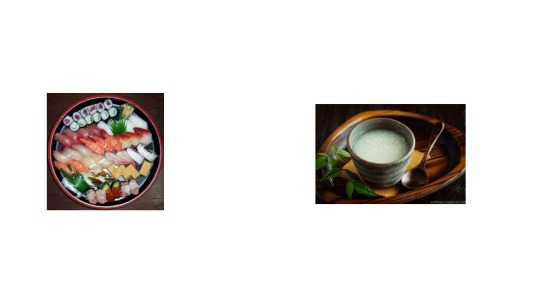
0 notes